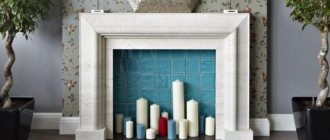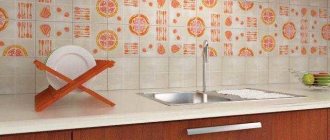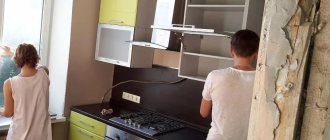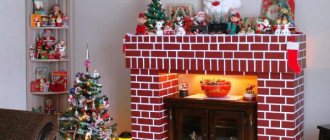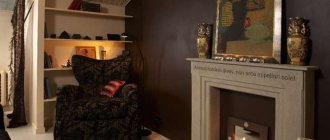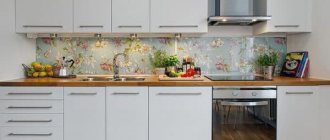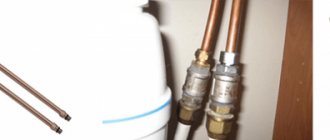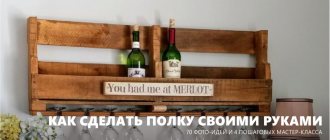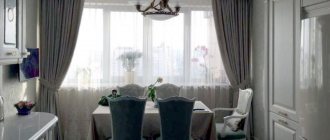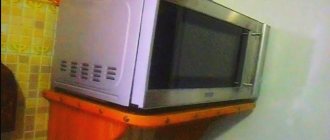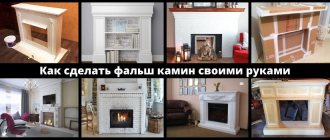It is difficult to find a material that is more durable and wear-resistant than tiles, but the complexity of installation and its rather high cost make us look for other options.
False panels for the kitchen are a modern, functional alternative to ceramic tiles, which were previously widely used to decorate the apron of the work area. The variety of materials, their decorative capabilities and ease of installation are often decisive when choosing the optimal solutions.
Replacing such an apron if necessary or if you want to change the interior is cheaper and happens faster than in the case of ceramic wall decoration.
Why are false panels needed?
False panels are used to hide the unsightly legs of bedside tables or kitchen appliances, using the same material as the set itself. The use of false panels in the kitchen allows you to hide pipes, voids, unsightly cracks, or as decoration. This design will also help in leveling the walls. The false panels match the color of the furniture that is installed in the room to give it an elegant look.
If you don’t know how to hide unevenness or too large gaps, use special false panels, which can be either opening or non-removable. Such false panels are often attached with magnets. You can resort to latches.
A beautiful glass apron can become a bright accent and at the same time hide imperfections
Attention! Builders recommend installing a removable version in cases where they cover wires or pipes, only in those places to which there must be constant access.
How to attach to walls?
The installation of false panels in the kitchen work area is usually performed permanently. But it is possible to install the finishing material so that the masked panel can be removed from the problem area and put back in place.
The process of installing finishing panels can be carried out in several ways. Finishing panels can be mounted on:
- wood sheathing. Bars with a rectangular cross-section are placed vertically in increments of 0.5 m and secured with screws.
- metal profile. This type of lathing is beneficial for kitchens with high humidity and uneven walls.
- staples. In this case, simple construction staples are used to install the panels.
- glue. In this case, installation will require carefully leveling the walls, applying a primer and drying.
See the adhesive mounting option in the following video:
Types of material
Let's look at what materials are used to make false panels.
Tree
For such purposes, cedar, alder, maple or oak are used. Of course, natural wood looks rich. It is environmentally friendly and beautiful. However, using it for the kitchen is not entirely advisable, because it will quickly become unusable due to increased temperature and humidity and may crack or swell. To prevent this from happening, additional processing will be required, and this is an extra expense. Another disadvantage is the very high price
Chipboard
This option is used only in extreme cases. Few people will say a good word about such a foundation. This is, of course, due to low strength and severe deterioration from moisture and temperature. Such a false panel can easily ruin the entire appearance with twisted corners. However, the price is low - there is a large selection of designs.
MDF
This foundation is the best option both in terms of price and quality. It has a varied selection of colors and is resistant to temperature changes and high humidity. Withstands heavy loads. Produced by pressing.
PVC
Common materials for false panels, as they have a number of positive properties. Significant resistance to the negative environment in the kitchen, as well as ease of care. There is a wide variety of colors and it is possible to apply various prints and designs, as well as decorate with mosaics. Light enough.
But they also have disadvantages. Do not install above or near the stove. When heated, plastic releases harmful substances. On such falpanels, a corner may break off or a scratch may appear in the event of mechanical impact.
Glass
This is the most durable material of all presented. To make such false panels, triplex is used, this is one of the types of tempered glass. You can decorate them using photo printing or apply skinali. In general, this material has no serious drawbacks, which is why its price is much higher than others.
Metal
Stainless steel is used to make metal false panels. Easy to care for and reliable at home. Most often used directly near the stove. The material is not affected by corrosion and rust, so it will last a long time. As a rule, it has the same color - matte.
Fake diamond
The material imitates various types of stone: granite, marble. It looks like a complete coating without seams. It looks beautiful in the interior, is easy to use and durable in everyday life. It's not very expensive. In case of mechanical damage (chip or scratch), the restorer can easily restore it.
The tabletop and panel in the same color made of marble in the interior looks expensive and stylish
For your information! To install the panels, it is best to seek the help of a professional who can easily create cozy masterpieces.
Rules for choosing a design
Depending on their purpose or your wishes, false panels can play the role of an accent in the interior or, conversely, not attract attention, copying neighboring surfaces.
- Panels with photo printing, plain but bright colors, or panels imitating exotic wood species, such as zebrawood, are used as accent decor.
- To make the false panel neutral, it needs to be matched to the tone of neighboring surfaces, for example, countertops, kitchen facades or walls. Otherwise, you can choose universal shades and textures - “wood”, white, silver metallic, as well as frosted or transparent glass.
Also take note of the following tips:
- On dark surfaces, dust and stains are more noticeable than on light or variegated ones.
- It is advisable to use colorful and bright wall panels, for example, with photo printing, provided the interior is laconic.
- If your kitchen is small, then you should choose light-colored panels to decorate the work area. They will not reduce the space and will reflect light.
DIY installation methods
Before you begin, you should understand the principles of fixation. It is done with staples, screws or liquid nails. Taking into account the physical properties of the prepared walls, installation is carried out:
- On wooden guides;
- On a metal profile;
- Directly to a flat surface.
Each of the listed methods implies its own technology, represented by a combination of techniques and materials.
If you have curved walls and the material of the false panels is made of polymers, it is better to use rigid fixation with hardware or glue along the guides. This is especially necessary when using decorated glass slabs. For smooth walls, it is advisable to optimize the process by using the technology of gluing false panels directly to the surface.
We will look at how to fix it in a particular case and what tools will be needed using the example of a standard kitchen with panel walls. And although these points significantly depend on the quality of workmanship and the material of the walls, the general difference, say, between fastening using two types of guides, differs only in the type of hardware and the adhesion force of the glue.
Tools
For concrete and brick walls where you plan to install false panels, you must have a hammer drill, a screwdriver or a universal screwdriver, a sealant (glue) gun, a tape measure and a level. In the latter case, an accurate rack level is sufficient. For the profile you will need metal scissors.
For smooth walls, including dry sheet materials, there is no need to drill anything; here it is important to correctly mark and apply glue in an even layer. Therefore, based on this and the type of material of the future apron, you most likely will not need a hammer drill. It is more important to acquire a wide spatula, a flat brush and a hacksaw for processing PVC and wood products and to avoid obstacles.
Preparatory stage
Installation on smooth walls by gluing with liquid nails, usually accompanied by cleaning the surface of wallpaper, crumbling lime, and plaster. If false panels, in addition to metal and glass panels, were purchased with a reserve in length, then it should be cut in advance, taking into account the bypass of natural obstacles of sockets, furniture protrusions, and walls before applying the adhesive.
Kitchen walls that are curved along the plane can only hold the panels along guides, that is, along the sheathing. Regardless of the type, it is necessary to cut them to length. If the kitchen has high humidity and poor ventilation, soak unpainted wooden guides with any antiseptic (bio-impregnation) before using them.
Fastening the apron with dowels and screws
Fastening an MDF apron in the kitchen with self-tapping screws or mounting dowels is done as follows.
- First, holes are marked on the panel blank and holes are drilled for the inserts of the decorative caps.
- Then, having positioned the panel at the installation site, mark the marks of the holes for the nylon dowels. This method will avoid displacement of the holes.
- Having removed the panel, drill technological holes and then install nylon dowels.
Installing a decorative cap
The panel is secured with self-tapping screws or screws through inserts onto which decorative chrome caps are screwed onto threads. Of course, this fastening method requires accuracy and more time, but in the future, if necessary, it allows you to quickly replace partially or completely the wall elements of the kitchen apron.
Required tool:
- Metric tape measure.
- Pencil.
- Screwdriver.
- Drill.
- Hammer.
A set of fasteners for attaching an MDF apron in the kitchen
First, a plastic dowel is installed in the technological hole flush with the wall surface, then a brass bushing with a silicone damper is put on, and secured with a self-tapping screw. The last thing to install is the chrome decorative cap.
Kitchen apron made of MDF, secured with dowels
False panels for the kitchen (41 photos): an affordable alternative to ceramics
Recently, a frequent addition to the modern kitchen is wall paneling, which has become an alternative to ceramic tiles. We are talking about such a concept as a false panel for the kitchen - the price of which is significantly lower than the cost of ceramics.
A raised panel in your kitchen is an integral part of modern design
In addition, this innovation will not require you to spend additional money on installation - this procedure is easy to do yourself. Let's talk about this in more detail.
Advantages and disadvantages
We recommend that you read our list of the advantages and disadvantages of raised panels over other types of finishes to decide whether they are suitable for use in your kitchen
Please note that in addition to the general list, it is also necessary to take into account the features of each material - we wrote about them just above
False panels have many advantages.
The undeniable advantages of fake kitchen panels include:
- Relatively low cost. Even the most expensive materials, such as wood and glass, will cost you less than ceramic or acrylic panels. In addition, false panels do not require expensive maintenance and are highly durable.
- Wide selection of materials. You can easily choose the appropriate option for any budget and interior style - from simple MDF panels to multi-component designer false panels with patterns and mosaics.
- Easy to care for. Often, it is enough to simply wipe the false panel regularly to remove dirt. You don't need polishes, special sponges or other expensive tools.
- Easy installation. Unlike other methods of decorating an apron, you can install a false panel yourself.
The main thing is to choose quality materials.
If we talk about the disadvantages, then we can only highlight the toxicity of some materials used for false panels. However, this disadvantage can be easily circumvented if you do not install them directly above the stove.
Main purpose
Finishing false panel slabs are needed mainly for decorative purposes, since other means and structures are used to strengthen or insulate the internal walls of the house. The main purpose of false panels is to mask existing imperfections in a wall or other area, such as cracks and voids. It is worth acquiring them in the following cases:
- if there is a need to level a small section of a horizontal surface;
- to improve the appearance of nondescript areas between interior parts;
- to hide electrical wiring and water pipes;
- to hide any fastening structures or supports;
- if you need to cover niches;
- if it is necessary to protect walls from moisture, for example, in the kitchen near the stove or in the bathroom.
In some situations, this type of finishing material may be useful in the process of decorating lighting. In this case, products are selected in accordance with the requirements for the color background of walls and furniture.
What it is?
A decorative finishing board is commonly called a false panel. It can not only effectively decorate the interior, but also hide the shortcomings of the room.
It is often chosen as an apron. It can be based on decorative sheets made from laminated chipboard, less often from MDF, in which one side has a beautiful design.
Experts recommend installing false panels when the need arises:
- replace the old kitchen apron with a new one;
- disguise the corrugation from the hood;
- close communications, niches, defects, irregularities;
- cover furniture legs;
- close the gaps formed between the wall and the cabinets;
- create conditions for decorative lighting;
- give the walls a flat surface.
The photo below shows an example of corrugation camouflage:
And in the other photo below is the wood-look finish of the MDF apron.
Finishing with decorative slabs to imitate concrete walls:
Installation
Before you add a false panel to your kitchen, you need to choose the appropriate option. In this matter, you need to focus not only on your own preferences, but also on operating conditions. If you need a durable and reliable surface, it is best to look at quality materials. A good choice for creating a finish would be glass or solid wood.
During the purchasing process, you need to find out about the presence of fireproof properties of materials, as this is important during operation.
To finish the apron, you need to use moisture-resistant types that are not afraid of exposure to high temperatures. If you choose a material solely for decorative purposes, you can use a wide variety of options. Fire-resistant panels are suitable for hiding communications.
After choosing the material, you need to decide on the size of the finish. It is best to do this before purchasing panels, having previously measured the parameters, which will facilitate the selection process.
After purchasing the appropriate option, you can begin installation.
You can install the false panel yourself, without turning to a specialist for help. The main thing that is required of you in this case is to follow the step-by-step process. First you need to eliminate the defects that have formed on the wall. This applies to various irregularities and crevices that appeared during operation. It is best to attach false panels before placing kitchen furniture. This is especially true for various hanging structures.
Assembling the lower box with a false facade
Today we will look at the assembly of a lower box with a so-called false facade (about the same as shown in this article).
Such extreme lower modules are made in cases where their façade cannot fully open due to the fact that a nearby window sill interferes with it.
In this case, a façade is designed that acts as a blank wall to which the hinged door of the module is attached.
So, from the very beginning, after assembling the module, there is no need to stuff the back wall onto it, since it will interfere with the installation of the fronts.
The façade we are considering is simple; it will not be possible to secure it from the outside with confirmations, as they will ruin the entire appearance. It needs to be secured from the inside through regular corners.
To do this, we attach the corners to the box itself (to the lower horizon, side and body strip). To make the corners “steel” evenly, we rest them against a regular plank, then we cap them with an awl and tighten them with self-tapping screws.
Space under the sink
The communications of the sink, its pipes, siphons and the sink itself do not allow full use of the space under the sink. But there is a way out. You can use a special cabinet in the shape of the letter “P”. This is the optimal place to store cleaning products, sponges, wipes and other sink supplies.
The cabinet in the shape of the letter “P” goes around the communications and does not interfere with the functioning of the sink
Having even the smallest kitchen, it can be stuffed so that in terms of functionality it will not be inferior to any large and spacious kitchens. You just need to be smart and creative.
What are the benefits of MDF decor panels, disadvantages and advantages
The MDF wall top is a thin, flexible sheet covered with decorative plastic or PVC film. Most often this is an imitation of the texture of stone, textiles or a fantasy design.
Manufacturers of postforming produce MDF decor panels for kitchen aprons with a standard width of 600 mm and a length of 3050 mm. The material can be easily cut to the desired length. The ends of such false panels remain untreated. It is difficult to glue them with an edge due to their thin thickness (usually 4-8 mm). Therefore, if the kitchen design project involves an open edge of the wall panel, you need to provide some design option. The easiest and cheapest way is to use plastic genesis for laying tiles. It can be matched to the color of the kitchen false panel and pasted during wall mounting.
